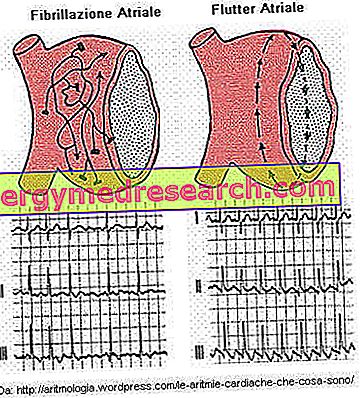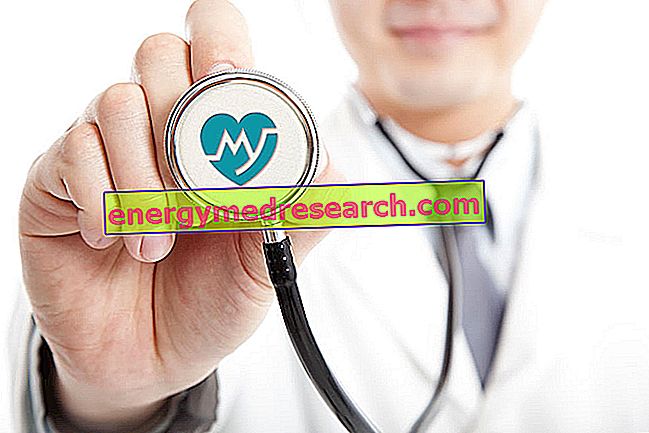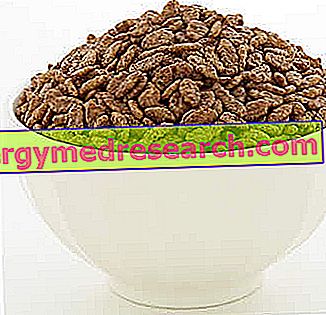Generality
Atrial flutter is an alteration of the heart rhythm that is located in the atrium; due to this arrhythmia, the heartbeat becomes irregular and usually high frequency (tachycardia). Compared to atrial fibrillation, these changes in heart rate are less pronounced and have a different impact on the ventricle.
Given the manner in which they appear, two types of atrial flutter can be distinguished: a paroxysmal, abrupt and sudden appearance, and a permanent, more gradual appearance. As regards causes, symptoms, diagnosis and therapy, the characteristics of atrial flutter and atrial fibrillation are very similar. In fact, as with atrial fibrillation, the onset may be due to pathological causes, such as heart disease or hyperthyroidism, or to other factors, such as alcohol and drug abuse, smoking, caffeine, etc. Spontaneous onset is also possible in people with otherwise healthy hearts. Regarding the symptoms, the subject suffering from atrial flutter has palpitation, dyspnoea, syncope, chest pain and asthenia, although sometimes these disorders are very mild or even absent.

Sometimes, flutter and atrial fibrillation can occur in the same patient: these are circumstances that deserve considerable attention from the doctor, as they are usually linked to the formation of thrombi or emboli.
NB: to understand some concepts illustrated in the article, it is necessary to know the bases of anatomy and physiology of the heart illustrated in the general article on cardiac arrhythmias.
What is atrial flutter
Atrial flutter is an alteration of the heart rhythm that originates in the atrium and is characterized by:
- Frequent contractions.
- Irregular beat.
- Sudden onset.
The arthritic disorder arises in the atrium and is transmitted to the ventricle. Therefore, cardiac output and blood circulation are also compromised. Both become irregular.
Atrial flutter affects about 1% of the population of Western countries; it occurs most in males and its incidence increases with age: in fact, the subjects most affected are those in their sixties and over sixties.
Given the area of onset, atrial flutter is classified among supraventricular ectopic arrhythmias .
Compared to atrial fibrillation, rhythm modifications are less marked . In fact, if during an atrial fibrillation the frequency of the atrial heartbeat can reach 400 beats per minute, during an atrial flutter the atrial heart rate can rise up to 240-300 beats per minute . A lower frequency results in a lower number of contraction pulses. Therefore, what changes with respect to atrial fibrillation is also the longer time allowed to the heart muscle (the myocardium) to "recharge" and return receptive to a new stimulus (refractoriness time). This time frame allows the heartbeat to become less messy .
Another important difference between flutter and fibrillation is the impact they have on the ventricle . During these two arrhythmic forms, part of the impulses is blocked at the level of the atrioventricular node, which stops part of the impulses directed towards the ventricle. This block is much greater in atrial flutter, so that the ventricular contraction can also be ¼ of the atrial one. The doctor, in fact, defines the flutter with the terms 2: 1, 3: 1 or 4: 1, to indicate that a stimulus can pass through the atrioventricular block, respectively, every 2, every 3 or every 4. The consequences of atrioventricular block concern cardiac output, which will be more or less affected based on the number of stimuli reaching the ventricle. It may seem complicated to understand this detail, but it is very important from a symptomatological point of view: in fact, the greater the ventricular frequency, the more obvious are the symptoms. In other words, the ventricular rate can vary greatly, from 180 beats per minute to less than 100. The fact that the ventricular rate can fall within the normal range should not be surprising: it often happens that the flutter goes unnoticed for this very reason .
Based on the impact on the ventricle and the way it arises, atrial flutter is distinguished in two forms :
- Paroxysmal . The frequency of the beat is very high. The onset is abrupt and the atrial contractions exceed the atriventricular block with remarkable effectiveness, of 2: 1 and, in some rare cases, also of 1: 1. The ventricular frequency, therefore, can even reach 120-180 beats per minute. The paroxysmal form characterizes the isolated manifestations, which occur in a healthy individual. It lasts a few hours, at most a few days, very often it runs out by itself. This excludes the use of drugs or other therapeutic interventions.
- Permanent . The frequency is lower than the paroxysmal form. The appearance is less sudden, but more subtle, and the contractions exceed the block of the atrioventricular node with an efficiency of 3: 1, 4: 1 and even 5: 1. Thus, the ventricular rate is lower than the paroxysmal form and may not, in some cases, exceed 100 beats per minute. The permanent form can last for years and go unnoticed, although it is synonymous, in most cases, with an associated pathology. We need a specific therapy and a general therapy: the first to act against the associated pathology; the second to act against flutter.
For the rest, it will be seen that flutter and atrial fibrillation have many features in common.
Causes
The causes of atrial flutter are numerous. As with atrial fibrillation, the most often determining factors are heart disease. In fact, an individual with heart failure due to rheumatic or valvular heart disease is more likely to develop episodes of atrial flutter.
The most influential heart disorders are:
- Rheumatic heart disease.
- Valvular heart disease (or valvulopathy).
- Myocardial infarction.
- Coronary.
- Pericarditis.
- Hypertension.
Hypertension is not really a cardiopathy, but it is a factor that predisposes to myocardial infarction and coronary heart disease. For this reason, it appears in the list.
The non-cardiac disorders, which cause flutter, are instead:
- Hyperthyroidism.
- Obesity.
- Gastroesophageal reflux.
- Respiratory diseases.
- Electrolytic imbalances.
Finally, even some non-pathological factors can determine the appearance of an atrial flutter. The arrhythmic episode usually appears, in the presence of these circumstances, in healthy individuals and has a spontaneous exhaustion.
- Alcohol abuse.
- Drug abuse.
- Smoke.
- Anxiety.
- Drugs.
- Excess of caffeine.
The correction of these behaviors, not in line with a healthy lifestyle, helps to solve the problem and prevent stable forms of atrial flutter. In fact, it should not be forgotten that some of the behaviors on the list are the prelude to the aforementioned cardiac pathologies.
Symptoms and complications
The main symptoms are:
- Palpitation (or heartbeat).
- Vertigo.
- Syncope.
- Chest pain (angina pectoris).
- Dyspnoea.
- Anxiety.
- Asthenia (weakness).
The symptomatology is closely related to the form of atrial flutter manifested by an individual. The paroxysmal forms, at very high frequency, show more evident symptoms, but it should not be overlooked that the greatest danger lies behind the permanent forms. It is at the origin of these, in fact, that there is a pathological disorder.
The most serious complication, induced by atrial flutter (albeit to a lesser extent than atrial fibrillation), is the predisposition, in the affected subject, to develop a cerebral ischemic stroke . This is due to the fact that the numerous irregular contractions, which first strike the atrium and then the ventricle, negatively affect cardiac output and blood flow. The latter becomes more turbulent. A turbulent flow has a high probability of creating lesions inside the vessels and, consequently, forming thrombi, that is solid and stable masses of platelets (thrombocytes), which serve to repair the lesion. The thrombus acts as an obstacle to the blood flow, occluding the vessels. For the continuous passage of blood, it can flake and give life to emboli, that is free particles made of platelet cells. Emboli, traveling through the vascular system, can reach the brain and prevent regular blood circulation in the brain area. This complication is more likely to occur if, in the affected individual, at atrial flutter, atrial fibrillation episodes are also alternated or if the patient is affected by valve disorders with atrial dilation (such as mitral stenosis).
The thrombo-embolic risk associated with atrial flutter is however lower than that of atrial fibrillation.
Diagnosis
Accurate diagnosis requires a cardiological examination. The traditional tests, valid for the evaluation of any atrial arrhythmia / flutter, are:
- Wrist measurement.
- Electrocardiogram (ECG).
- Dynamic electrocardiogram according to Holter.
- Chest x-ray.
- Echocardiography
Wrist measurement . The cardiologist can draw fundamental information from the evaluation of:
- Arterial pulse . The measurement is performed on the radial artery. It informs about the frequency and regularity of the heart rhythm.
- Jugular venous pulse . It is useful for understanding the level of venous pressure.
Electrocardiogram (ECG) . It is the instrumental examination indicated to evaluate the progress of the electrical activity of the heart. Based on the resulting traces, the doctor can recognize and distinguish an atrial flutter from an atrial fibrillation.
Dynamic electrocardiogram according to Holter . This is a normal ECG, with the very advantageous difference that monitoring lasts for 24-48 hours, without preventing the patient from performing normal daily activities. It is useful when episodes of atrial flutter are sporadic and unpredictable.
Chest x-ray . It is a clinical investigation that aims to understand if there are particular pulmonary and respiratory diseases .
Echocardiography . Taking advantage of the ultrasound emission, this non-invasive investigation shows the fundamental elements of the heart: atria, ventricles and valves. The evaluation of the heart allows to verify the presence of a valvular disease or some other cardiac malformation.
Therapy
The therapy depends on the form of atrial flutter and the state of health in which the subject affected by the arrhythmic episodes finds itself.
If it is a paroxysmal flutter, it acts as follows:
- Medication administration:
- Digital . Heart rate slows down
- Antiarrhythmics : quinidine derivatives, dofetilide, ibutilide, flecainide, propafenone and amiodarone. They are used to normalize the heart rhythm.
- Electrical treatment:
- Cardioversion . Non-invasive technique, which infuses an electric shock, called shock, in order to reset the altered heart rhythm and restore the normal heartbeat, marked by the atrial sinus node.
Maintenance treatments, always based on digitalis and antiarrhythmics, are also indicated to prevent other paroxysmal episodes, especially if you are certain that the patient suffers from hyperthyroidism or hypertension.
It is, however, important to point out that some circumstances, such as:
- Tolerable symptoms.
- Spontaneous resolution, in the past, of other episodes of atrial flutter.
- Absence of cardiac and non-cardiac pathologies.
they make the therapy unnecessary. This is to avoid any side effects related to taking medications, such as quinidine gastrointestinal disorders.
If the atrial flutter is permanent, very often it means that at the origin of the disorder there is a cardiopathy or a pathology of other nature. Solving this condition, with a therapeutic approach chosen on a case by case basis, is the fundamental step to help restore normal heart rhythm. The therapy, on the other hand, aimed at treating atrial flutter, acts as a support and maintenance. It is the following:
- Medication administration:
- Digital .
- Antiarrhythmics : quinidine derivatives, dofetilide, ibutilide, flecainide, propafenone and amiodarone.
- Anticoagulants . Permanent forms can create a situation of thrombo-embolism. They are used in the presence of particular cardiopathies, the mitral valvulopathies, which could generate thrombi or emboli.
- Beta blockers and calcium channel blockers . Slow down the heart rate, acting at the level of the atrioventricular node. They are administered to those who are digital tolerant.
- Electrical treatment:
- Cardioversion . It is no longer indicated, when the patient is suffering from a heart disease that alters the structure of the heart, such as valvulopathies.
- Trans-catheter radiofrequency ablation . A catheter is used which, once conducted to the heart, is able to infuse a radiofrequency discharge affecting the area of myocardium that generates atrial flutter. The affected area is destroyed and this should rearrange the number of contraction pulses by the atrial sinus node. It is an invasive technique.
See Also: Medications to Treat Atrial Flutter »



